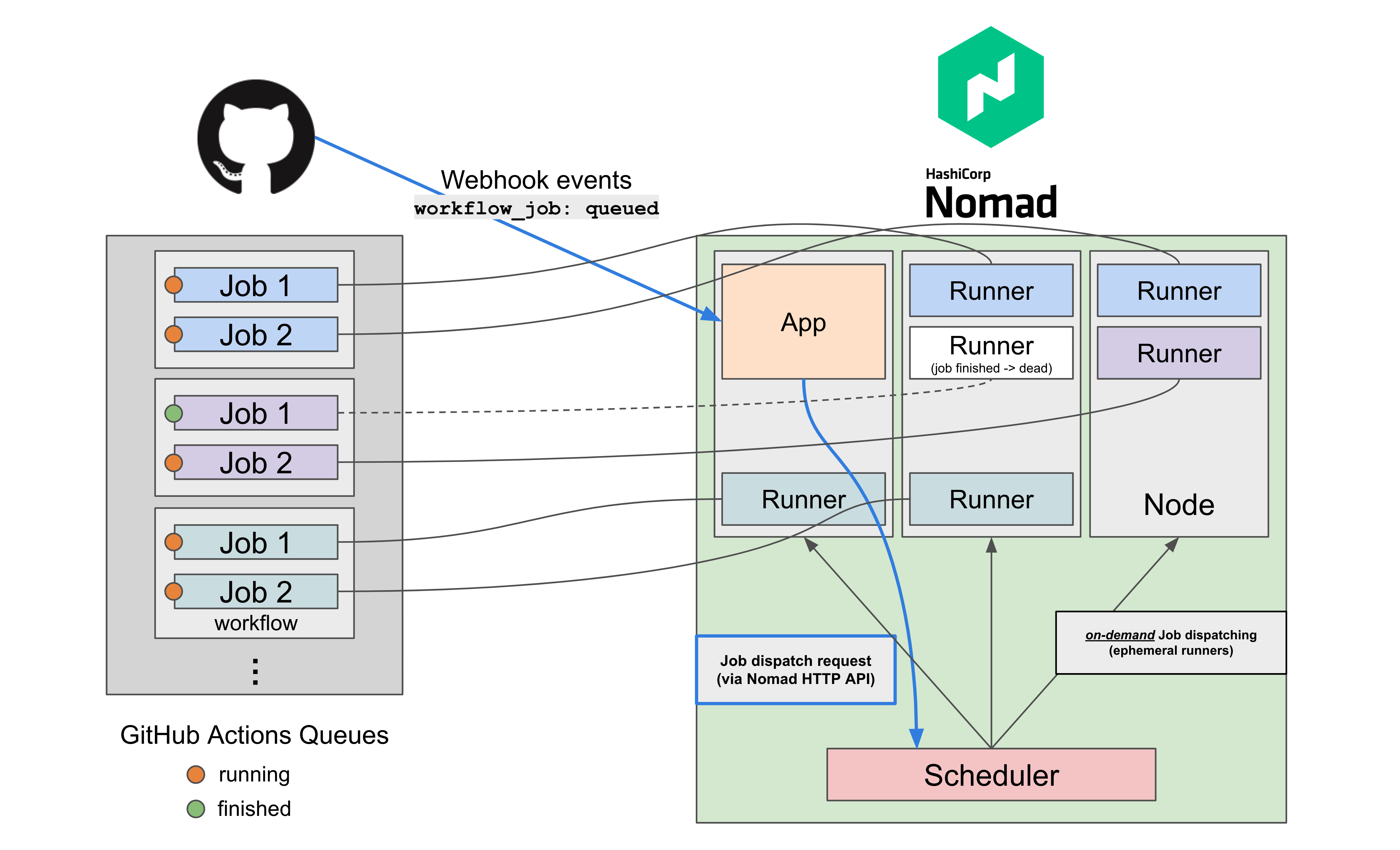nomad-github-runners-autoscaler
A demo-purpose Node.js application that listens to the GitHub Webhooks event (workflow_job.queued) and dispatches Nomad parameterized jobs using Nomad HTTP API to launch "on-demand" GitHub Actions Self-hosted Runners easily and efficiently.
This application implements the suggested autoscaling pattern mentioned in the GitHub documentation below:
(optional) Horizontal Nomad Cluster Autoscaling
While this demo app shows you a conceptual way of auto-scaling GitHub Actions Self-hosted runners on your Nomad Cluster, you may also want to ensure that there is always an appropriate amount of Nomad cluster resource to run your runners' workload at scale. This is achievable by using Nomad Autoscaler.
Deploy to Docker
You may use a pre-built example jrsyo/nomad-github-runners-autoscaler:alpha image on the Docker Hub, or build your own using the Dockerfile in this repository.
Environment Variables
The following environment variables should be passed accordingly to run this app container.
PORT: the port number the server will listen on in the container (default:3000)GH_WEBHOOK_SECRET: your configured GitHub Webhook secretNOMAD_HOST: the Nomad host address (e.g.,http://example.com:4646)NOMAD_JOB_ID: the Nomad Job ID to dispatchNOMAD_TOKEN: the Nomad token (requires permission to dispatch jobs)
docker run -d --restart always --name nomad-github-runners-autoscaler \
-e GH_WEBHOOK_SECRET="mysecret" \
-e NOMAD_HOST="http://127.0.0.1:4646" \
-e NOMAD_JOB_ID="github_runner" \
-e NOMAD_TOKEN="foo" \
-p 8080:3000 \
jrsyo/nomad-github-runners-autoscaler:alphaDeploy to Nomad cluster
example architecture overview
NOTE: These examples assume that you have already set up Nomad Vault integration on your Nomad cluster to avoid hard-coding your GitHub personal access token to obtain the runner tokens on-demand. See Vault integration for more details.
Or, you could remove the vault and template stanzas and pass secrets via the normal env stanza.
example (webhook server)
This example job exposes the app container on port 8080 on the deployed Nomad node and lets the app container process incoming webhook requests directly. Therefore, you can't run multiple app containers (i.e., the count parameter).
This example is not meant to be a production-ready showcase. In a realistic environment, you should consider running load balancers in front of your apps. Please refer to HashiCorp's official learning guide resources such as Load Balancer Deployment Considerations.
* Since Nomad 1.3 will add a built-in service discovery feature, using the template stanza and accessing other services' address information does not necessarily require Consul as before.
job "gh_webhook_server" {
datacenters = ["dc1"]
type = "service"
vault {
policies = ["github-hashicorp-demo"]
change_mode = "noop"
}
group "server" {
count = 1
network {
port "http" {
static = 8080
}
}
task "app" {
driver = "docker"
# fetch secrets from Vault KV secret engine
template {
env = true
destination = "secret/gh-webhook-server.env"
data = <<EOF
NOMAD_TOKEN = "{{with secret "demos-secret/data/github-hashicorp-demo"}}{{index .Data.data "nomad-token"}}{{end}}"
GH_WEBHOOK_SECRET = "{{with secret "demos-secret/data/github-hashicorp-demo"}}{{index .Data.data "github-webhook-secret"}}{{end}}"
EOF
}
env {
PORT = "8080"
NOMAD_HOST = "http://${NOMAD_IP_http}:4646"
NOMAD_JOB_ID = "github_runner"
}
config {
image = "jrsyo/nomad-github-runners-autoscaler:alpha"
ports = [
"http",
]
}
}
}
}example (GitHub Actions Runners)
See myoung34/docker-github-actions-runner for more details about configuration options.
In this example job file, GH_REPO_URL is defined as a required metadata key. This metadata value is used in the env stanza to pass the REPO_URL environment variable dynamically, so the demo app always sends this metadata when calling the Dispatch Job Nomad HTTP API endpoint. This way, we can have a reusable job definition across your repositories.
Also, as a possible improvement, by further utilizing the Actions runs-on: custom labels, you could send as many arbitrary metadata for parameterized jobs. This might be useful to limit jobs resources (e.g., cpu/memory) as well as have fine control of the target nodes with constraint and/or affinity, for instance.
job "github_runner" {
datacenters = ["dc1"]
type = "batch"
parameterized {
payload = "forbidden"
meta_required = ["GH_REPO_URL"]
}
vault {
policies = ["github-hashicorp-demo"]
change_mode = "signal"
change_signal = "SIGINT"
}
group "runners" {
task "runner" {
driver = "docker"
# fetch secrets from Vault KV secret engine
template {
env = true
destination = "secret/vault.env"
data = <<EOF
ACCESS_TOKEN = "{{with secret "demos-secret/data/github-hashicorp-demo"}}{{index .Data.data "github-pat"}}{{end}}"
EOF
}
env {
EPHEMERAL = "true"
DISABLE_AUTO_UPDATE = "true"
RUNNER_NAME_PREFIX = "gh-runner"
RUNNER_WORKDIR = "/tmp/runner/work"
RUNNER_SCOPE = "repo"
REPO_URL = "${NOMAD_META_GH_REPO_URL}"
LABELS = "linux-x86,t2-micro"
}
config {
image = "myoung34/github-runner:latest"
privileged = true
userns_mode = "host"
# Allow DooD (Docker outside of Docker)
volumes = [
"/var/run/docker.sock:/var/run/docker.sock",
]
}
}
}
}GitHub PAT (Personal Access Token) vs GitHub Apps
The Nomad job file above requires a valid GitHub PAT (Personal Access Token) in order to register a new Runner to a given GitHub repository.
While this works fine, PAT is a static and long-lived secret that you may want to avoid sharing across teams. Therefore, GitHub actually recommends using GitHub Apps and generating a short-lived token instead.
To do so, since the myoung34/docker-github-actions-runner Docker image currently doesn't support authenticating with GitHub Apps upon start-up, you can do a little hack using Nomad's init task pattern to generate a token in the prestart lifecycle stage.
See an example here.
Docker in Docker
The GitHub Runner itself doesn't support DinD (Docker in Docker): actions/runner#406
But you could do DooD (Docker outside of Docker) instead: actions/runner#406 (comment)
